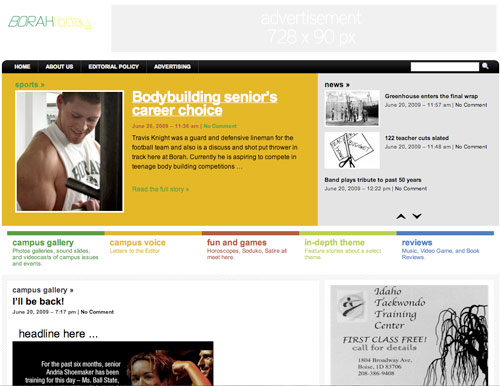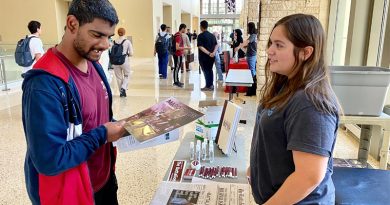Review of NAAF/Ball State Emerging Media Workshop
 As a high school newspaper adviser, I had expected my student staff to launch our publication into the digital age. After all, they text, follow MySpace and Facebook, and rarely reply to emails anymore in a timely fashion. At the Ball State University Emerging Media Workshop June 19-21, I realized how important a role I play in the digital curriculum of my students.
As a high school newspaper adviser, I had expected my student staff to launch our publication into the digital age. After all, they text, follow MySpace and Facebook, and rarely reply to emails anymore in a timely fashion. At the Ball State University Emerging Media Workshop June 19-21, I realized how important a role I play in the digital curriculum of my students.
Sponsored by a grant from the Newspaper Association of America Foundation, the workshop offered 20 high school newspaper advisers the opportunity to learn and create a publication Web site. We began by learning how to create our own blogs: http://harmonreview.wordpress.com/category/emerging-media-workshop/. Although participants ranged in ages, teaching experience, and journalism backgrounds, one thing we all had in common was that we weren’t sure how to help our staffs create a successful online presence.
For instance, my school’s newspaper website was created by a computer whiz who graduated last year. When he was on the newspaper staff, he wrote three versions of the code underlying the website. Although he remains willing to help with the site for free, it’s difficult to have a remote editor who is no longer on staff or attending high school. Unfortunately, the website, although a step in the right direction, has been little more than an electronic version of the print newspaper. Poorly edited and low-quality videos on topics that somehow always included my newspaper students dancing in front of the camera have been the Web site’s only added value.
“Photo galleries get 10 times more hits than videos do,” said one of three instructors, Ryan Sparrows, who teaches newspaper design and multimedia storytelling at BSU. He introduced the group to “picture stories”: still pictures and audio linked together via a computer editing program, such as Soundslides. “Video is not necessarily interactive unless you consider pushing the play button interactive,” he added. We learned that picture stories, like those on the New York Times site “One in 8 Million” or on MediaStorm, offer readers more complete options to listen, watch, and read in a number of combinations. I thought my students wanted a quality online publication as much as I did. I suffered from the syndrome of thinking that just because my students are part of the digital age that they know instinctually how to create a digital age product. What I discovered at the workshop is that they need tools and resources, and just enough knowledge to help guide them.
Instructor Aaron Manfull, JEA Digital Media Committee Chair and high school newspaper adviser, said digital high school newspapers should be the primary driver, and print versions should be secondary. An online news source houses current events and offers social engagement, while a print newspaper supplements it. “How can you start a conversation between your print paper and your online one?” said Manfull. “How can you go beyond just dumping content?” That was “a paradigm shift,” said Sue Skalicky from Central High School in Bismark, ND.
Enter Erin Cubert, the third instructor, and first social media director for the Nashville Tennesean. Now, she’s a project manager for South Central Media in Nashville, where she manages internal creative and technical resources for Web site development projects. While Cubert taught the group Web site mechanics and social media, Manfull guided us in WordPress and blogging, and Sparrows gave tips on multimedia storytelling.
WordPress is the Web site CMS that was used in the workshop. Attacking the goal from three angles was effective, as every adviser who attended the workshop had the fundamentals of a working newspaper website in just under 30 hours of instruction (11 a.m. to 9 p.m. Friday, 8 a.m. to 9 p.m. Saturday, and 8 a.m. to 3 p.m. Sunday). My website can be viewed at http://borah.highschoolmedia.org. I plan to introduce the Web site to my journalism students and pass on the information I learned.




